John handled the art of the Ancient Near East for us. The Walters' collection of items from the ANE is small, compared to the collections from Egypt, Greece and Rome, but the ANE is so important that this small room comprises one fourth of every tour devoted to the Ancient World. There is plenty to talk about here.
John is phenomenal at helping us pick interesting objects to use for teaching. In this room, however, I found myself a bit confused because there are over 4000 years, and several different cultures, represented. That wouldn't stop me from giving a tour good enough for 5th graders, but just for myself I wanted something more. So I turned to the reading for a general outline, and I will put the objects we discussed in that general context. We don't need to know all this for our tours, and in fact too much information would make everyone's eyes glaze over. But I am fascinated by this "cradle of civilization" and these Biblical lands. Here goes.
Thousands of years ago, certain peoples in lands fertile enough to support them gave up the dangerous wandering life of hunter-gatherers and became farmers and herders. One of the first places that this occurred was in Mesopotamia, the "land between the rivers." There, humans learned to use the wheel and the plow, developed a system of writing, and participated in an incredibly advanced culture.
Among the first of these known cultures were the Sumerians, who around the 4th Millenium BC transformed the "fertile crescent." Ancient Sumer was composed of city-states, each with a protective deity. Among these, Ishtar, the goddess of love and war, is the most important female deity. Others crop up at various times with various names. More on them as they come up.
Sumerian communal living was directed by priests and rulers. Only a portion of the population needed to work to produce food, so others could specialize in other pursuits. The common needs for defense against enemies or against nature were met by the city-state, another big development at this time. And trade was vital. The land was fertile, but lacking in important resources such as metal, stone and wood. (This will influence the art greatly.)
The Sumerians used first pictographs and later cuneiform to communicate and keep records of commercial transactions. The development of cuneiform marked the beginning of writing as historians strictly define it. Once the Sumerians had writing, they had literature, including the late 3d millenium epic Gilgamesh.
The gods played a central role in the daily life of the ancient Sumerians. Huge temple complexes became administrative centers. They were built of mud brick, so few examples survive, but from what we can discern, temples were placed on raised platforms to reach the sky (where the gods were presumed to live). (The tallest such temple platform, or ziggurat, at Babylon gave rise to the story of the Tower of Babel, but not until later.)
Because stone was so scarce, things made of stone tended to be small. The sculpture that survives shows that these ancient cultures developed a style of narrative storytelling in stone, with friezes and a ground line to tell the story, composite frontal and profile views of the human figure, and hierarchical scale.
Ur was home to the Biblical Abraham, and also obviously home to aristocratic people who buried their dead in regal fashion. The cemetery at Ur, discovered in the 1920s, yielded amazing discoveries of artwork, jewelry, gold objects and musical instruments. Among the precious objects were stamp seals and cylinder seals which are an incredible source of information about society at the time.
The Walters has a wonderful collection of seals. Seals show recurring themes in ancient Near Eastern art - humans interacting with gods and animals, for example - and were used to show ownership or to protect jars and doors against unauthorized opening. The seals were carved by undocumented craftsmen in hard stone, sometimes more precious stones, using small bronze tools. Seals were either stamped or rolled over clay. The display case and the drawers below at the Walters contain the seals and hardened clay to show the images once applied.
There are also wonderful tablets that represented business letters, land transfer documents, and business instructions. This is one of the earliest, a protoliterate tablet to illustrate the use of pictographs.
And I like this one, a small tablet giving instructions to a traveling buyer. I think of it as an ancient "text message." The text of the message is, in part: This is important. Buy for the 16 minas of silver some red gold for smelting and send it to me with your servant! This is important: a dishonest man must not cheat you! To drink do not succumb!
In 2332 BC, the loosely-linked group of cities known as Sumer came under the domination of a great ruler, Sargon of Akkad. This culture became known as the Akkadians. Akkadian portraiture embodies the new concept of absolute monarchy. The Akkadians may have been the first to develop the skill of hollow-casting metal sculptures. (This method was used in Ancient Greece as well.)
In about 2150 BC, a Neo-Sumerian state ruled by the kings of Ur was established. During this time, Gudea built or rebuilt many temples (and placed statues of himself in them). We don't have any statues of Gudea, but the Walters has two small votive offering figurines representing Baal, a war god and bringer of autumnal rains, and Anat, a fertility goddess and the sister and consort of Baal. Good to know what the temples were for.
The resurgence of Sumer was short-lived, and for about two centuries independent city-states existed side by side. One local ruler was Kapara, who built his palace at Tell Halaf. The Walters has four relief stones used in that palace. Kapara was a "waste not, want not" kind of guy, however, so he re-used stones from earlier buildings in his palace. The Walters reliefs may be from several different buildings originally, but Kapara put his inscription on each of them. He alternated them red and black along the lower course of an exterior wall of his palace. The image on the left represents a caravan trader. From the beginning of the 1st Millenium BC the domestication of dromedaries made the caravan trade possible. This relief may be the earliest representation of a dromedary rider. (It might be interesting to note for tours that frankinscence and myrrh were luxury items traded at the time. ) The image on the right of two [funny looking] heroes beating on a fearsome monster may represent the Gilgamesh story.
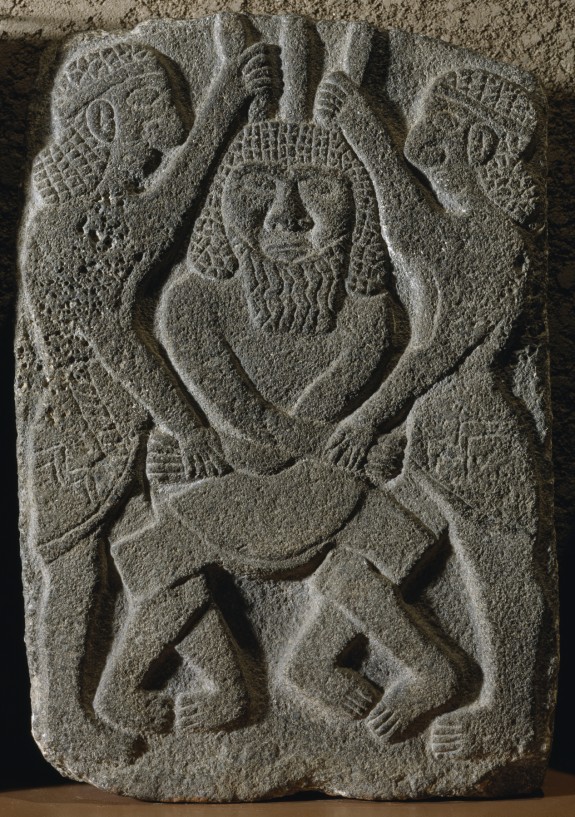
This stand, probably for an offering bowl, is also from this time. It is hollow-cast in bronze using the "lost wax" method. (Although its exact origin is in question, the ibex, a type of wild goat, was a sacred animal found in other art of this time. There were lots of city states.)
Hammurabi was one of the most powerful of the kings and centralized government in southern Mesopotamia for a time. He is known today for his code of law. We don't have that at the Walters. We do have this lovely boundary stone from that era, recording a grant of land from the king (Marduk, represented on the stone) to an individual. One copy of the land grant was kept at the temple, the other on the land. Note the costume of the king, who wears the tall Babylonian feathered crown and an elaborately decorated garment. On the top are deities who witnessed the land grant. (Maybe only a lawyer would like this piece.)
Back to the timeline of history: Then there were the Hittites and the Elamites, mentioned in the Old Testament. But in about 900 BC, the fearsome Assyrians vanquished the others and ruled a huge empire for several hundred years. Their favorite god was Ashur. The Assyrians built a huge palace at Nineveh and covered the walls with images of themselves as all-powerful and merciless to their enemies. The Walters owns this relief showing an Assyrian soldier undermining the wall of a beseiged Elamite city. The Assyrians conquered Elam in the 7th C. BC.
The Assyrians also built a huge palace at Nimrud and covered its walls with propaganda as well. The Walters' Winged Genius guarded one of the doors of that palace. He was probably using his pinecone-shaped object to either bless the king or water the tree of life. The inscription across his garment reads in part: great king, strong king, king of the universe, king of Assyria, valiant man who acts with the suppor of Aszszur, his lord, and has no rival among the princes of the four quarters, marvelous shepherd, / fearless in battle, mighty flood-tide which has no opponent, the king who subdues those insubordinate to him, he who rules all peoples, strong male who treads / upon the necks of his foes, trampler of all enemies . . .
There are lots of symbols to note about the Winged Genius. His jewelry represents the goddess Ishtar; his horned crown means that he is a deity. His clothing is fascinating and feathered. He would have been elaborately painted.
I think it's safe to say that every tour will include him.
Among the small items from the Assyrians are these gorgeous carved ivories. They were probably used to decorate wooden furniture. One represents a winged griffin nibbling at the sacred tree, the other a cow suckling a calf.
For a more experienced audience, it might be fun to compare these animals with the ones on the Tell Halaf reliefs.
The Assyrians talked a good game, but their empire was never very secure: even by the time of the Winged Genius it was beginning to disintegrate. For a while the Neo-Babylonians held sway (think Nebuchadnezzar of Biblical fame) and restored Babylon to its former glory. The famous hanging gardens were among the Seven Wonders of the Ancient World, and the enormous ziggurat (the Tower of Babel) was also famous, perhaps infamous. The city was still built of mud brick, but now glowing with dazzling glazes. It was a city of wondrous color, described in the Bible in the Book of Daniel.
But it was captured by Cyrus of Persia in the 6th C. BC. The Persians built Persepolis, a huge citadel. Reliefs decorated the walls of the terrace and staircases leading to the royal audience hall. They represented guards, nobles and representative of 23 subject nations bringing the king tribute. We have one example at the Walters. The clothing of this offering-bearer distinguishes him as a Mede, one of the conquered peoples.
Alexander the Great conquered the Persian Empire in 330 BC, and ushered in a long period of Greek and then Roman rule of large parts of the ancient Near East. Seleucus I, one of Alexander's generals, founded the Seleucid dynasty. The Walters has this lovely frieze with oryx heads from that time. It originally formed part of the left side of a stela and is carved from calcite alabaster. It was found in South Arabia.
With the increasing influence of Greco-Roman culture during the 2d and 3d C. AD, new artistic styles and motifs are found in Near Eastern art. This fragment of a pediment, on loan to the Walters, is an example of these influences. Note the composite beast in the upper left and the fertility goddess rising out of the grapes and leaves.
In the 3d C. AD, the Sasanians challenged the Romans and sought to kick them out of Asia. The Sasanians established the New Persian Empire which endured until the Arabs drove the Sasanians out of in 636 CE, four years after the death of Muhammad. The Sasanians used compositional motifs and patterns from Roman art in different ways. We don't have any examples of this art at the Walters. Still it is worth noting that the Sasanians were the last great pre-Islamic culture. Thereafter, we look to the art of Islam.


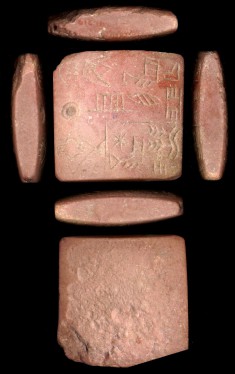

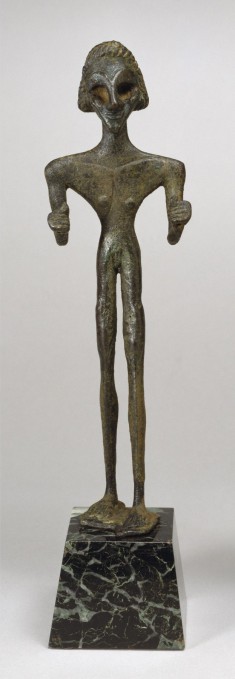




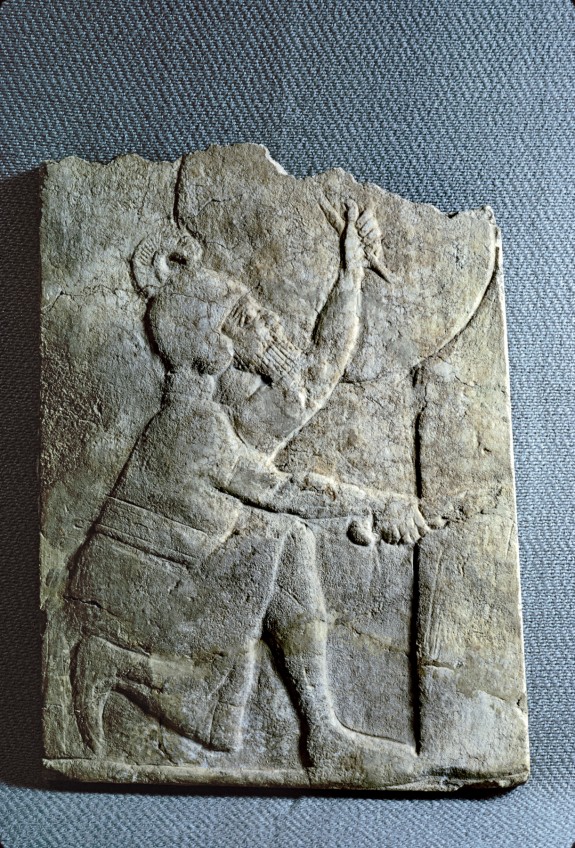




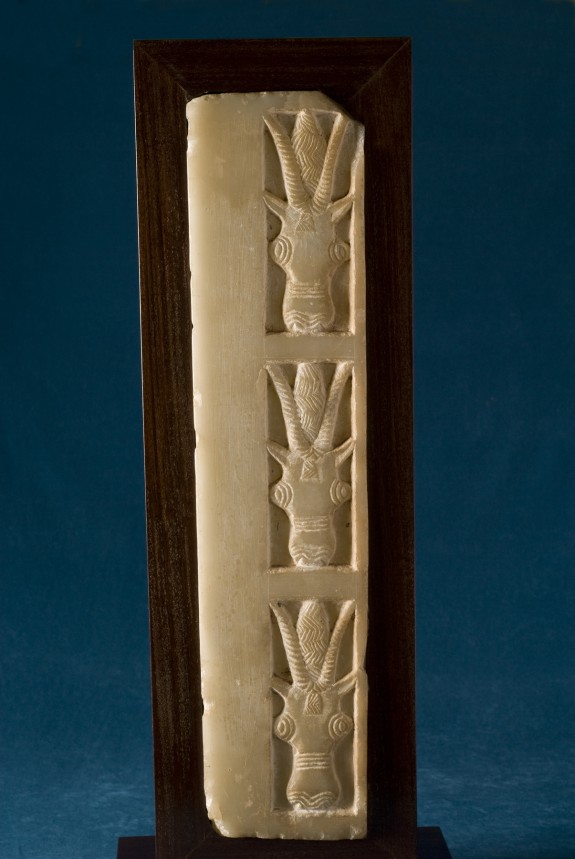

No comments:
Post a Comment